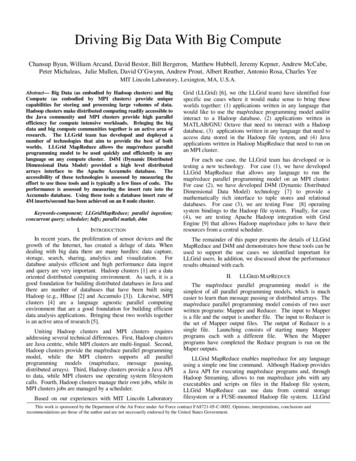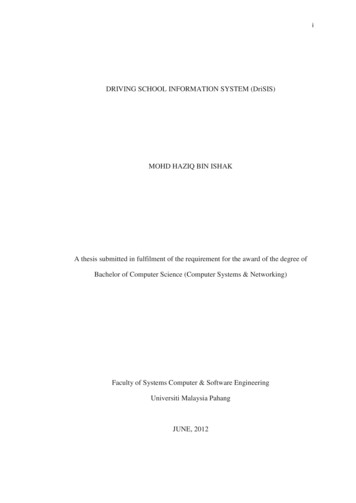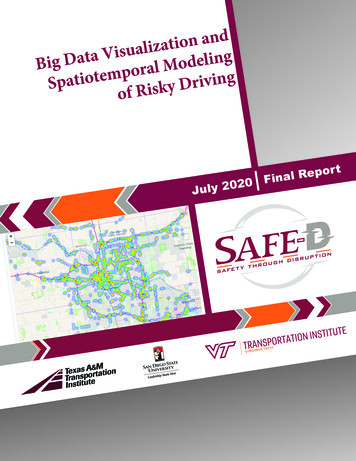
Transcription
Driving Big Data With Big ComputeChansup Byun, William Arcand, David Bestor, Bill Bergeron, Matthew Hubbell, Jeremy Kepner, Andrew McCabe,Peter Michaleas, Julie Mullen, David O’Gwynn, Andrew Prout, Albert Reuther, Antonio Rosa, Charles YeeMIT Lincoln Laboratory, Lexington, MA, U.S.A.Abstract— Big Data (as embodied by Hadoop clusters) and BigCompute (as embodied by MPI clusters) provide uniquecapabilities for storing and processing large volumes of data.Hadoop clusters make distributed computing readily accessible tothe Java community and MPI clusters provide high parallelefficiency for compute intensive workloads. Bringing the bigdata and big compute communities together is an active area ofresearch. The LLGrid team has developed and deployed anumber of technologies that aim to provide the best of bothworlds. LLGrid MapReduce allows the map/reduce parallelprogramming model to be used quickly and efficiently in anylanguage on any compute cluster. D4M (Dynamic DistributedDimensional Data Model) provided a high level distributedarrays interface to the Apache Accumulo database. Theaccessibility of these technologies is assessed by measuring theeffort to use these tools and is typically a few lines of code. Theperformance is assessed by measuring the insert rate into theAccumulo database. Using these tools a database insert rate of4M inserts/second has been achieved on an 8 node cluster.Keywords-component; LLGridMapReduce; parallel ingestion;concurrent query; scheduler; hdfs; parallel matlab, d4mI.INTRODUCTIONIn recent years, the proliferation of sensor devices and thegrowth of the Internet, has created a deluge of data. Whendealing with big data there are many hurdles: data capture,storage, search, sharing, analytics and visualization. Fordatabase analysis efficient and high performance data ingestand query are very important. Hadoop clusters [1] are a dataoriented distributed computing environment. As such, it is agood foundation for building distributed databases in Java andthere are number of databases that have been built usingHadoop (e.g., HBase [2] and Accumulo [3]). Likewise, MPIclusters [4] are a language agnostic parallel computingenvironment that are a good foundation for building efficientdata analysis applications. Bringing these two worlds togetheris an active area of research [5].Uniting Hadoop clusters and MPI clusters requiresaddressing several technical differences. First, Hadoop clustersare Java centric, while MPI clusters are multi-lingual. Second,Hadoop clusters provide the map/reduce parallel programmingmodel, while the MPI clusters supports all parallelprogramming models (map/reduce, message passing,distributed arrays). Third, Hadoop clusters provide a Java APIto data, while MPI clusters use operating system filesystemcalls. Fourth, Hadoop clusters manage their own jobs, while inMPI clusters jobs are managed by a scheduler.Based on our experiences with MIT Lincoln LaboratoryGrid (LLGrid) [6], we (the LLGrid team) have identified fourspecific use cases where it would make sense to bring theseworlds together: (1) applications written in any language thatwould like to use the map/reduce programming model and/orinteract to a Hadoop database, (2) applications written inMATLAB/GNU Octave that need to interact with a Hadoopdatabase, (3) applications written in any language that need toaccess data stored in the Hadoop file system, and (4) Javaapplications written in Hadoop MapReduce that need to run onan MPI cluster.For each use case, the LLGrid team has developed or istesting a new technology. For case (1), we have developedLLGrid MapReduce that allows any language to run themap/reduce parallel programming model on an MPI cluster.For case (2), we have developed D4M (Dynamic DistributedDimensional Data Model) technology [7] to provide amathematically rich interface to tuple stores and relationaldatabases. For case (3), we are testing Fuse [8] operatingsystem bindings to the Hadoop file system. Finally, for case(4), we are testing Apache Hadoop integration with GridEngine [9] that allows Hadoop map/reduce jobs to have theirresources from a central scheduler.The remainder of this paper presents the details of LLGridMapReduce and D4M and demonstrates how these tools can beused to support the use cases we identified important forLLGrid users. In addition, we discussed about the performanceresults obtained with each.II.LLGRID MAPREDUCEThe map/reduce parallel programming model is thesimplest of all parallel programming models, which is mucheasier to learn than message passing or distributed arrays. Themap/reduce parallel programming model consists of two userwritten programs: Mapper and Reducer. The input to Mapperis a file and the output is another file. The input to Reducer isthe set of Mapper output files. The output of Reducer is asingle file. Launching consists of starting many Mapperprograms each with a different file. When the Mapperprograms have completed the Reduce program is run on theMaper outputs.LLGrid MapReduce enables map/reduce for any languageusing a simple one line command. Although Hadoop providesa Java API for executing map/reduce programs and, throughHadoop Streaming, allows to run map/reduce jobs with anyexecutables and scripts on files in the Hadoop file system,LLGrid MapReduce can use data from central storagefilesystem or a FUSE-mounted Hadoop file system. LLGridThis work is sponsored by the Department of the Air Force under Air Force contract FA8721-05-C-0002. Opinions, interpretations, conclusions andrecommendations are those of the author and are not necessarily endorsed by the United States Government.
MapReduce identifies the input files to be processed byscanning a given input directory or reading a list from a giveninput file as shown in the step 1 in Fig. 1. Then, by accessingthe scheduler at the step 2, it creates an array of many tasks,called an array job, which is noted as “Mapper Task 1”,“Mapper Task 2”, and so on. Modern schedulers such as theopen source Grid Engine [10] provide an array job with anoption to control how many tasks can be processedconcurrently. Once the array job is created and dispatched forexecution, each input file will be processed by one of the taskswith the specified application at the command line, noted as“Mapper” in Fig. 1. The application can be any type ofexecutable, such as a shell script, a Java program or anyexecutable programs that are written in any languages.Figure 1. An example diagram showing how LLGrid MapReduce works.Once all the input data are processed, there is an option tocollect the results, if there are any, by creating a dependent taskat the step 3, which is noted as “Reduce Task” in Fig. 1. Thereduce task will wait until all the mapper tasks are completedby setting a job dependency between the mapper and reducetasks. The reduce application is responsible to scan the outputfrom the mapper tasks at the step 4 and to merge them into thefinal results at the step 5.resource usage makes it possible for one cluster to supportmany more map/reduce users. An important example of thisphenomena is ingesting into a database where there is almostalways a maximum ingest rate beyond which adding moreingestors will not help and can even degrade performance.Another advantage of LLGrid MapReduce is that there isno internal map/reduce API. So the Mapper and Reducerprograms can be written and debugged on the users’workstation without any additional software.III.DYNAMIC DISTRIBUTED DIMENSIONAL DATA MODEL(D4M)The MATLAB/GNU Octave language, sometimes referredas M language, is the most popular language at the LincolnLaboratory. We have developed several parallel computationtechnologies (e.g., pMatlab [11,12], MatlabMPI [4], andgridMatlab [6]) that allow efficient distribution of data across aparallel computer. In addition, the LLGrid team has developedand deployed the D4M to allow these users to work naturallywith databases. D4M allows linear algebra to be readily appliedto databases. Using D4M, it is possible to create composableanalytics with significantly less effort than using traditionalapproaches. Furthermore, with existing LLGrid technologies,D4M parallel MATLAB implementation can providesignificant performance enhancement in database insertion andquery.The LLGrid MapReduce command API is shown in Fig. 2.The map application has two input arguments, one for inputfilename and the other for the output filename. The reduceapplication takes one argument as input, the directory pathwhere the results of the map tasks reside. The reduceapplication scans and reads the output generated by the maptasks.LLGrid MapReduce –-np nTasks\--mapper myMapper \--reducer myReducer \--input input dir \--output output dir \[--redout output filename]Figure 2. LLGrid MapReduce APIOne of the advantages using LLGrid MapReduce is that thenumber of concurrent map tasks are controlled by the user withthe --np option. This feature gives the user precise control ofhow many resources they are using and greatly reducesconflicts between users on the same system. In addition, itmake much simpler for the user to optimize their programs todetermine what the optimal number of resources are toconsume. Allowing users to control and optimize theirFigure 3. D4M Matlab prototype architecture. At the top is the userapplication consisting of a series of query and analysis steps. In themiddle is the parallel library that hides the parallel mapping of theoperations. On the bottom are the databases (typically tuple stores)running on parallel computing hardware.D4M uses layered implementation that allows each layer toaddress a specific challenge as shown in Fig. 3. The top layerconsists of composable associative arrays that provide a one-toone correspondence between database queries and linearalgebra. Associative arrays can be both the input and output ofa wide range of database operations and allow complexoperations to be composed with a small number of statements.Associative arrays are implemented in Java and M languages,approximately 12,000 lines of source code, which provide aneasy way to create the interface to the middle and bottomlayers. The middle layer consists of several parallelcomputation technologies (e.g., pMatlab [11,12], MatlabMPI
[4], and gridMatlab [6]) that allow associative arrays to bedistributed efficiently across a parallel computer. Furthermore,the pieces of the associative array can be bound to specificparts of one more databases to optimize the performance ofdata insertion and query across a parallel database system. Thebottom layer consists of databases (e.g., Accumulo [3] orSQLServer) running on parallel computation hardware. D4Mcan fully exploit the power of databases that use an internalsparse tuple representation (e.g., a row/col/val triple store) tostore all data regardless of type. Constructing complexcomposable query operations can be expressed using simplearray indexing of the associative array keys and values, whichthemselves return associative arrays. For exampleA(’alice ’,:)A(’alice bob ’,:)A(’al* ’,:)A(’alice : bob ’,:)A(1:2,:)A 47.0alice rowalice and bob rowsrows beginning with alrows alice to bobfirst two rowsall entries equal to 47.0Finally, associative arrays can represent complexrelationships in either a sparse matrix or a graph form.Associative arrays are thus a natural data structure forenvironments such as Matlab to perform both matrix andgraph algorithms.IV. DATA INGESTION PERFORMANCEIngest into a database is a good test of showing how easy touse the LLGrid MapReduce and D4M are for such a task. Thisis also an important example of the kind of application that cantake advantage of combining a Hadoop cluster and a MPIcluster.There are several approaches to ingest data into thedatabases. In the LLGrid environment, the LLGrid MapReducecommand can deploy the data ingestion tasks to the LLGridwith minimum user efforts by using the underlying scheduler.It creates an array job for the given data set. The array job ismade of many tasks and each task processes a given input data.The task can be used to ingest the results into the databases.LLGrid MapReduce allows to execute any programs that areusing the appropriate database binding API commands.Through the scheduler’s feature with the array job, it cancontrol how many ingestion tasks can be processedconcurrently.This allows users to specify the maximumnumber of concurrent ingestion tasks in order to optimize thedatabase performance as well as controlling the number ofcompute resources in the pool.As a demonstration for LLGrid MapReduce, a Pythonscript is launched by LLGrid MapReduce to parse a set of webproxy log files, stored in the tabular CSV formation and toingest the results into the Accumulo database. In thisdemonstration, the LLGrid MapReduce command creates anarray job of 24 tasks that read and parse the input files of 3.8GBytes as shown in Fig. 4. The processing takes about 5minutes. The demonstration has been performed with twodifferent configurations: an Accumulo setup with 8 nodes (7tablet servers) and an Accumulo setup with 4 nodes (3 tabletservers). Each tablet server handles requests such as ingestionand query for one or more tablets, which in turn form anAccumulo database table. [1] Each node has 24 processingcores. Both cases were able to achieve about 1.5 million and800,000 ingestion per second, respectively, in average.Figure 4. LLGrid MapReduce for Accumulo data ingestion using a Pythonscript.A similar but bigger set of web proxy log files are used forthe ingestion scalability study as shown in Fig 5. In this case,two different sets of data are used. The size of the smaller setwas about 17 GBytes, which holds about 200 files, with sizesare ranging from 8 to 200 Mbytes. This set is used for theingestion experiment with up to 64 processes. With 128 and256 processes, we used another set of web proxy log files madeup of about 1000 files, approximately 90GBytes. The databaseused for the study is Accumulo (version 1.3.5) with 8 nodes (7tablet servers). In this experiment, because of the nature of therow keys (base64-encoded hashes), we pre-split the table by thebase64 characters to ensure 100% tablet coverage and evendistribution across tablet servers. This, of course, requiressecondary indices of relevant columns (i.e. the transpose oforiginal table), where pre-spitting is done via decomposition ofthe value domain.Figure 5. Total ingestion rate versus number of processes when running 7tablet servers on an Accumulo cluster.The result, shown in Fig. 5, shows that the ingestion ratescales superlinearly in the beginning and then, linearly up to 64processes. With 128 and 256 cores, we were able to achieveaverage tablet server loads between 500K and 600K ingestionper second. However, beyond 64 processes, the total ingestionrate starts diminishing as the number of processes are growing.This indicates that peak ingestion rate has been achieved. Infact, with 7 tablet servers, using 128 processes producessignificantly higher ingest performance per unit of load thanusing 256 processes. With 256 processes, the total ingestion
rate was increased up to 4 million inserts per second. This is100x performance improvement over the single ingestionprocess. The observed performance is considered to be asignificant achievement when comparing the ingestion ratereported by a YCSB benchmark [13] although their clusterconfiguration and ingested data are quite different.Another demonstration for data ingestion into theAccumulo has been performed using a D4M parallel MATLABimplementation on LLGrid. In this case, we have used theGraph500 benchmark [14] to generate the input data. ApMatlab application constructs a D4M associative array inparallel and ingests the associative array using the D4M putmethod, which binds to the Accumulo database API. Byparallelizing the code with the parallel MATLAB, we cancontrol the number of concurrent processes for data ingestion.Similar to LLGrid MapReduce example, the parallel MATLABprocesses are executed on the LLGrid cluster (HPC computenodes) and each process communicates with the Accumulodatabase directly.Fig. 7 and 8 show the ingestion performance history with asingle and six tablet servers in the Accumulo cluster,respectively. In both cases, 16 MATLAB clients are ingestingdata into the Accumulo. Fig. 7 shows that the ingestion rate istopped out around 100K entries/second. It appears that thesingle tablet server was busy with 16 MATLAB clients all thetime and reached its maximum ingestion rate with the currentconfiguration.Figure 7. Time history of the data ingest rate when a single tablet server isrunning in the Accumulo cluster.Fig. 6 shows the average data insertion performance withmultiple nodes when one or six tablet servers running in theAccumulo cluster (each node has 2 cores). The Accumulodatabase cluster is made of one Hadoop name node, which isalso the master server for the Accumulo, and six Hadoop datanodes, which are also running the Accumulo tablet servers.Figure 8. Time history of the data ingest rate when six tablet servers arerunning in the Accumulo cluster.However, as shown in Fig. 8, when running six tabletservers (one tablet server per each Hadoop HDFS data node)there are still more rooms to accommodate incoming dataingestion requests and its peak ingestion rate becomes morethan 250K entries/second. This is approximately 2.5 timesgreater than the case with a single tablet server. Although theingestion rate does not scale linearly with the number of tabletservers, for ingestion performance, it is desirable to run onetablet server per each Hadoop data node.Figure 6. Total data insertion rate versus number of nodes when one or sixtablet servers are running in the Accumulo cluster.In this case, only one MATLAB process is running pernode and each node is inserting about 2 million entries at a timeand repeating it 8 times, which is total of 16 million entries pereach MATLAB process. Since we fixed the ingestion data pereach MATLAB process, as the number of MATLAB processesgrows, so the size of the ingested data grows linearly. For asingle tablet server case, as increasing the number of clients,the ingestion rate increases linearly initially, up to 4 clients andthen, flattened out beyond 8 clients. When using 8 MATLABclients, the ingestion rate peaked at about 105K entries/secondand then decreased with 16 clients. However, if 6 tabletservers (one tablet server per each Hadoop HDFS data node)are running, the ingestion rate continues to scale well up to 32clients.V.DATABASE QUERY PERFORMANCEUsing appropriate query commands, the desiredinformation can be extracted from databases. Accumulo isdesigned to search large amounts of data. We have studied howwell it scales under various conditions. In this study, we usedthe D4M parallel MATLAB implementation of the Graph500Benchmark to demonstrate a multi-node query. With D4M, thequery operation is accomplished via an array indexing, whichsimplifies coding significantly.In this study, we selected an arbitrary vertex in the graphand queried any column or row entries associated with it. Thetimes for a couple of queries in the column and row direction,respectively, were measured and compared in Fig. 9 and 10.As expected, the column query times are 3 to 4 orders ofmagnitude larger than those of the row query. As increasingthe number of the concurrent query clients, the column querytime increases significantly where as the row query time is
remained almost same although there is some abnormaldeviation when running 8 MATLAB clients with a single tabletserver as shown in Fig. 10. Fig. 9 also shows that the querytakes a lot longer time to perform with one tablet server ascompared to 6 tablet servers.second. Since in this simulation, only one tablet server isrunning in the Accumulo cluster, it indicates that the number ofactive tablets are varied over the time, which caused the scanrate changes as a step fashion.Figure 11. The scan rate history at the beginning of the query operation by 16concurrent MATLAB clients while only a single tablet server is running.Figure 9. The column query times with respect to various number ofconcurrent query clients to the Accumulo database when running a single andsix tablet servers, respectively.Figure 12. The scan rate history at the end of the query operation by 16concurrent MATLAB clients while only a single tablet server is running.Fig. 13 and 14 show a similar scan rate history graphs when6 tablet servers (one per each data node) were running. Thesescan rate history graphs show that they are highly fluctuatingwith time. However, when comparing the peak scan rate, thescan rate with 6 tablet servers is about twice faster as comparedto the scan rate with a single tablet server.Figure 10. The row query times with respect to various number of concurrentquery clients to the Accumulo database when running a single and six tabletservers, respectively.Fig. 11 and 12 show the time history of the scan rate at thebeginning and at the end of the query operations, which wererequested by 16 concurrent MATLAB clients while only asingle tablet server was running in the Accumulo cluster. Thescan rate indicates how fast the scanner are able to retrieve thevalue associated with a given key. It also provides an insight ofhow many of the Accumulo tablets and tablet servers are beingused and how busy they are for the given query. As shown inFig. 11, over the period of the query time, its scan ratefluctuated significantly.In Fig. 11, during the first 10 minutes, the scan rate wasquite small as compared to the rest of the history. This couldbe caused by the fact that the test code does not have a barrierto synchronize the process between the ingestion and the querysteps. Another interesting thing is that the scan rate waschanged as a multiple of approximately 250K ingestions perFigure 13. The scan rate history at the beginning of the query operation by 16concurrent MATLAB clients while six tablet servers (one per data node) arerunning.Figure 14. The scan rate history at the end of the query operation by 16concurrent MATLAB clients while six tablet servers (one per data node) arerunning.
The performance of the scan rate fluctuates significantlywith time when using 6 tablet servers because it depends onhow many active Hadoop data nodes are participated at a giventime in addition to the number of active tablets. With 6 tabletservers, since the scan operation is spread out among 6 tabletservers, the rate change becomes more volatile than what wasobserved with a single tablet server. As expected, overall querytime is much shorter with 6 tablet servers: approximately twohours (6 tablet servers) and approximately four hours (singletablet server).VI.SUMMARYWe have demonstrated that an MPI cluster environment canbe used efficiently with a Hadoop cluster envrionment.LLGrid MapReduce and D4M along with pMATLABtechnologies make it easy to write the big data applications.Both cases show that the data insertion and query scales wellwith the increasing the number of clients and nodes whilerunning fully configured Accumulo clusters.REFERENCES[1][2][3]Apache Hadoop MapReduce http://hadoop.apache.org/mapreduce/Apache HBase http://hbase.apache.orgApache Accumulo 1][12][13][14]J. Kepner and S. Ahalt, “MatlabMPI,” Journal of Parallel andDistributed Computing, vol. 64, issue 8, August, 2004.B. Hindman, A. Konwinski, M. Zaharia, A. Ghodsi, A.D. Joseph, R.Katz, S. Shenker and I. Stoica, "Mesos: A Platform for Fine-GrainedResource Sharing in the Data Center", NSDI 2011, March 2011.N. Bliss, R. Bond, H. Kim, A. Reuther, and J. Kepner, “Interactive gridcomputing at Lincoln Laboratory,” Lincoln Laboratory Journal, vol. 16,no. 1, 2006.J. Kepner et al., “Dynamic distributed dimensional data model (D4M)database and computation system,” 37th IEEE International Conferenceon Acoustics, Speech, and Signal Processing (ICASSP), Kyoto, Japan,March 2012.FUSE http://fuse.sourceforge.net/Beta Testing the Sun Grid Engine Hadoop /beta testing the sun gridOpen Grid Scheduler http://gridscheduler.sourceforge.netJ. Kepner, Parallel Matlab for Multicore and Multinode Computers,SIAM Press, Philadelphia, 2009.N. Bliss and J. Kepner, “pMatlab parallel Matlab library,” InternationalJournal of High Performance Computing Applications: Special Issue onHigh Level Programming Languages and Models, J. Kepner and H.Zima (editors), Winter 2006 (November).S. Patil, et all., “YCSB : Benchmarking and performance debuggingadvanced features in scalable table stores,” ACM Symposium on CloudComputing 2011, Cascais, Portugal, October 2011.Graph500 benchmark http://www.graph500.org
Hadoop clusters provide the map/reduce parallel programming model, while the MPI supports all parallel clusters programming models (map/reduce, message passing, distributed arrays). Third, Hadoop clusters provide a Java API to data, while MPI clusters use operating system filesystem calls. Fourth, Hadoop clusters manage their own jobs, while in











